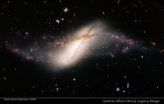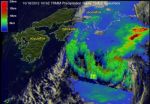(Press-News.org) It's fall football season, when fight songs and shouted play calls fill stadiums across the country. Another less rousing sound sometimes accompanies football games: the sharp crack of helmet-to-helmet collisions. Hard collisions can lead to player concussions, but the physics of how the impact of a helmet hit transfers to the brain are not well understood. A research team from the U.S. Naval Academy in Annapolis, Md., has created a simplified experimental model of the brain and skull inside a helmet during a helmet-to-helmet collision. The model illustrates how the fast vibrational motion of the hit translates into a sloshing motion of the brain inside the skull. The researchers will present their findings at the 164th meeting of the Acoustical Society of America (ASA), held Oct. 22 – 26 in Kansas City, Missouri.
Murray Korman, a professor in the physics department at the U.S. Naval Academy, worked with his student Duncan Miller during the course of a semester to develop the experimental model. To simulate a side collision, the researchers hung one helmet from the ceiling with clothesline and swung the second helmet into the first, like a pendulum. Accelerometers mounted on the helmets recorded the vibrations before, during, and after the hit.
Figuring out simple ways to model a human head inside the helmets was a challenge, Korman notes. Human cadavers were out, and crash test mannequins were too expensive. After reading up on skull vibrations, the team settled on a wide plastic hoop, shaped like the skirt of a bell. "They say that when you get hit, you get your bell rung. No pun intended, but your skull does kind of ring like a bell," Korman says.
The researchers modeled the brain as a brass cylinder cushioned in a slot carved out of open-cell foam that mimicked fluid within the brain cavity. By choosing simple materials the researchers minimized the complexity of their set-up while retaining those elements needed to capture the essential motions of the brain and the skull. They found that their brass cylinder brain sloshed back and forth within the skull much more slowly than the rate of vibration of the initial hit. Building a model is important, Korman notes, because it can help determine how a measurable parameter, like the acceleration of a helmet during a hit, would translate into potentially damaging brain motion. "The ultimate damage comes when the brain hits the side of the skull," Korman says.
Korman says there is still a lot of work to do to improve the model. He hopes in the future to collaborate with biophysicists to incorporate more detailed knowledge of the material properties of the brain and skull. Ultimately, the model might be used to test new helmets designed to better protect the brain from hits. Korman describes futuristic helmets that might crumple on impact like plastic car bumpers, leaving the only bell ringing on the field to be done by the marching band.
INFORMATION:
MORE INFORMATION ABOUT THE 164th ASA MEETING
The Kansas City Marriott Downtown Hotel is located at 200 West 12th Street, Kansas City, Missouri, 64105. The hotel main numbers are: 816-421-6800; fax: 816-855-4418.
USEFUL LINKS
Main meeting website: http://acousticalsociety.org/meetings/kansas_city
Meeting Abstract Database: http://asa.aip.org/asasearch.html
Hotel site: https://resweb.passkey.com/Resweb.do?mode=welcome_ei_new&eventID=8120158
WORLD WIDE PRESS ROOM
ASA's World Wide Press Room contains additional tips about newsworthy stories and with lay-language papers, which are 300-1200 word summaries of presentations written by scientists for a general audience and accompanied by photos, audio, and video.
PRESS REGISTRATION
ASA will grant free registration to credentialed full-time journalists and professional freelance journalists working on assignment for major news outlets. If you are a reporter and would like to attend, contact Charles E. Blue (cblue@aip.org, 301-209-3091), who can also help with setting up interviews and obtaining images, sound clips, or background information.
This news release was prepared for the Acoustical Society of America (ASA) by the American Institute of Physics (AIP).
ABOUT THE ACOUSTICAL SOCIETY OF AMERICA
The Acoustical Society of America (ASA) is the premier international scientific society in acoustics devoted to the science and technology of sound. Its 7,000 members worldwide represent a broad spectrum of the study of acoustics. ASA publications include The Journal of the Acoustical Society of America (the world's leading journal on acoustics), Acoustics Today magazine, ECHOES newsletter, books, and standards on acoustics. The Society also holds two major scientific meetings each year. For more information about ASA, visit our website at http://www.acousticalsociety.org.
END
Global temperatures directly affect the acidity of the ocean, which in turn changes the acoustical properties of sea water. New research suggests that global warming may give Earth's oceans the same hi-fi sound qualities they had more than 100 million years ago, during the Age of the Dinosaurs.
The reason for this surprising communication upgrade is that whales vocalize in the low-frequency sound range, typically less than 200 hertz, and the new research predicts that by the year 2100, global warming will acidify saltwater sufficiently to make low-frequency sound near ...
Noise can be distracting, especially to a person trying to concentrate on a difficult task. Studying annoying noises helps architects design better building environments and policy makers choose effective noise regulations. To better understand how short noise bursts affect humans' mental state, researchers from the University of Nebraska – Lincoln played quarter-second-long white noise clips to test subjects as they worked on arithmetic problems. The researchers noticed a slight general trend toward lower performance when louder noises were played, and also identified ...
Miss hitting the "sweet spot" on a baseball bat and the resulting vibrations can zing your hands. Bat companies have tried for decades to reduce these painful shocks with limited success. But Daniel Russell, a professor in the graduate program in acoustics at Pennsylvania State University in University Park, has figured out that bat vibrations between 600 and 700 hertz (Hz) cause the most pain and that specifically tuned vibration absorbers are the best at combatting the sting. He will present the results of his damping technique comparisons at the 164th meeting of the ...
Earthquakes sway buildings, buckle terrain, and rumble – both audibly and in infrasound, frequencies below the threshold of human hearing. New computer modeling by a team of researchers indicates that most of the low-frequency infrasound comes from an unexpected source: the actual "pumping" of the Earth's surface. The researchers confirmed their models by studying data from an actual earthquake.
"It's basically like a loudspeaker," said Stephen Arrowsmith, a researcher with the Geophysics Group at Los Alamos National Laboratory in Santa Fe, N.M., who presents his team's ...
VIDEO:
Einstein predicted gravity waves in his general theory of relativity, but to date these ripples in the fabric of space-time have never been observed. Now a scientific research technique called...
Click here for more information.
A pioneering technology capable of atomic-level precision is now being developed to detect what so far has remained imperceptible: gravitational waves or ripples in space-time caused by cataclysmic events including even the Big Bang itself.
A ...
Tropical Storm Maria is moving away from Japan and strong wind shear is pushing its rainfall east of the storm's center, according to NASA satellite imagery.
On Oct. 18 at 0845 UTC (4:45 a.m. EDT), NASA's Tropical Rainfall Measuring Mission (TRMM) satellite saw that rain associated with Tropical Storm Maria was limited to the east of the storm's center. Rainfall was also light to moderate, falling at a rate between .78 to 1.57 inches/20 to 40 mm per hour. There were no areas of heavy rain remaining in the tropical cyclone. The low-level center of the storm is now exposed ...
When the lamp is shattered,
The light in the dust lies dead.
When the cloud is scattered,
The rainbow's glory is shed.
These words, which open Shelley's poem "When the Lamp is Shattered," employ visions of nature to symbolize life in decay and rebirth. It's as if he had somehow foreseen the creation of this new Gemini Legacy image, and penned a caption for it. What Gemini has captured is nothing short of poetry in motion: the colorful and dramatic tale of a life-and-death struggle between two galaxies interacting. All the action appears in a single frame, with the ...
Heavy rainfall returned to Typhoon Prapiroon for a brief time on Oct. 18 when NASA's TRMM satellite passed overhead. Prapiroon is battling strong wind shear and is expected to transition into an extra-tropical storm in the next day.
NASA's Tropical Rainfall Measuring Mission (TRMM) satellite captured rainfall data on Prapiroon twice on Oct. 18 when it passed overhead. The first orbit was at 0845UTC and the second at 1019 UTC. TRMM's Microwave Imager (TMI) and Precipitation Radar (PR) data show that rain associated with Prapiroon was falling at a rate of over 75mm/hour ...
Hurricane Rafael is no longer a tropical cyclone. The storm merged with a cold front on Oct. 18, but not before NASA's Terra satellite captured an image of the storm when it was in its last day as a hurricane.
The Moderate Resolution Imaging Spectrometer (MODIS) instrument aboard NASA's Terra captured a visible image of Hurricane Rafael in the North Atlantic on Oct. 17 at 1440 UTC (10:40 a.m. EDT). Although Rafael was far from land, its northwestern fringe clouds were brushing Nova Scotia, Canada.
By 5 p.m. EDT on Oct. 17, Rafael had become extra-tropical, meaning that ...
In a new perspective piece being published Online First tonight in Annals of Internal Medicine, a physician recalls lessons learned from treating patients affected by the 2002 outbreak of Exophiala (Wangiella) dermatitidis meningitis or arthritis related to contaminated, injectable coticosteroids prepared from a compounding pharmacy.
According to the author, the lessons he learned in 2002 are applicable to the current outbreak. He warns that compounding of preservative-free corticosteroids requires meticulous sterility to ensure lack of fungal contamination. Without ...




